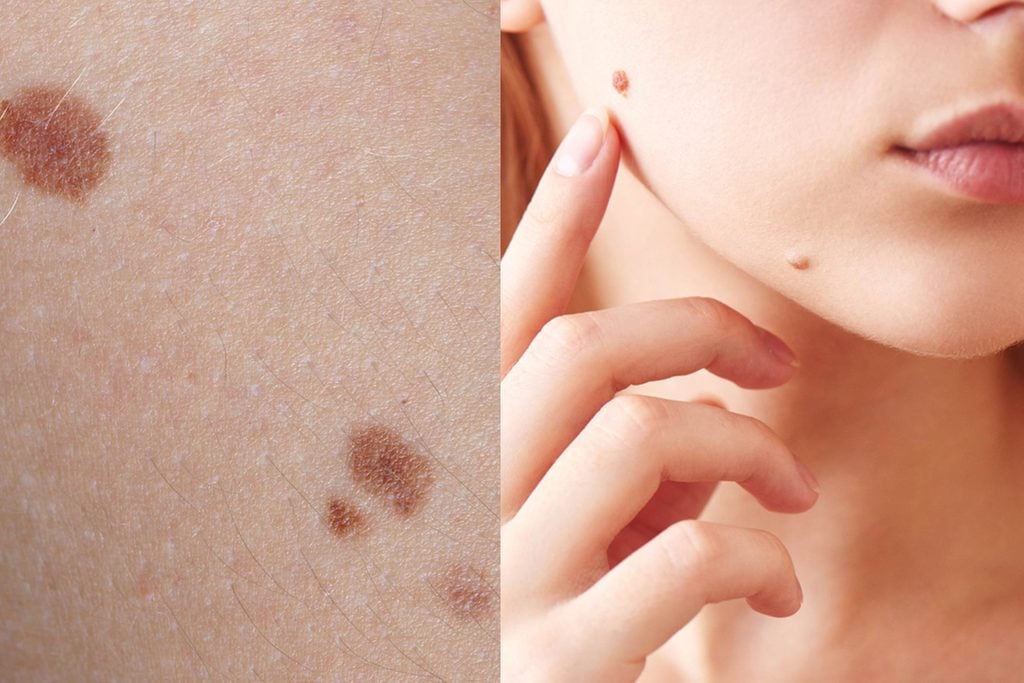I Tried Mole Mapping. Here’s What Happened.
Updated: Aug. 20, 2018
This preventative skin cancer measure may just save your life.

When someone says “mole mapping,” you’re most likely picturing someone taking a Sharpie and playing connect-the-dots with your moles. Maybe even naming each line things like, “Shoulder Blade Road” or “Gluteus Maximus Street.” But the actual procedure of mole mapping doesn’t even come close to that. It’s a technique where a skin specialist takes 20 to 30 digital photographs of your body from head to toe to document every single mole. Think of it like a modeling portfolio for your moles, except it won’t pay your bills and it may actually save your life by detecting skin cancer. That’s because the photographs are used as a baseline for your current mole pattern to identify potentially dangerous skin changes in the future.
Since two of my many moles have been biopsied before, my dermatologist thought I was the perfect candidate for the procedure. Mole mapping is recommended for anyone who has a family history of melanoma, new or changing moles, fair skin, more than 50 moles, and other factors. I met all of the above, which means that I’m a giant red bull’s-eye for melanoma. I would like to thank my Swedish and German ancestors for blessing me with their porcelain white skin that burns within minutes under the sun’s rays. Not to mention that I’m covered in moles or as my grandma calls them “fly poopies.” Basically, I’m covered in fly feces.
My dermatologist informed me that I’d have to strip down to my underwear for the occasion and I died a little inside since I’m quite camera shy. See, I’m not your stereotypical millennial with an iPhone full of selfies. In fact, I loathe having my picture taken, so I knew standing practically naked in front of a stranger with a camera would jostle my nerves a bit. But I decided I could shed my body image issues for the sake of my future health. It’s not like this was going to be plastered all over the cover of Reader’s Digest.
A roll of gray photo studio paper hangs on the wall and is spread out onto the floor with a footstool that stands on top of it. It’s plain and simple. There are no fancy photo shoot lights to highlight my facial features (just your average unflattering fluorescent lighting), no hair and makeup team (you’re not even allowed to wear makeup, anyway), and no fabulous stylists (my hospital gown will never be worn at New York Fashion Week). The skin specialist tells me to shed my hospital gown. I flash an appeasing smile but inside I’m filled with dread. Irrational thoughts start popping in my head: “I should have done some crunches this morning. Did I remember to shave the back of my thighs?” I step up on the stool and my clammy feet instantly stick to the white crinkly paper that lies across it. I suck in my stomach and breathe in and out, ready for my close up.
The camera is just like I envisioned. A standard camera similar to the ones the paparazzi shove in Kim Kardashian’s face. Except I feel like anyone but a Kardashian. (Side note: Some dermatologist offices use a special hands-free camera connected to a computer that automatically moves up and down on a stand to take your photos.)
A row of laminated sketches is on the floor in front of me. Each one features a different pose. The poses all have a limited range of motion, much like a Barbie doll’s. One pose reminds me of a freeze frame of walking—one foot extended out in front of the other while one arm is swung forward and the other back. Needless to say, mole mapping is not the place for hair flipping or hip jutting.
The first pose is easy: I stand straight forward with my arms to my side and my palms facing out. I don’t know if I should smile or not, so I just stare straight ahead. I’m sure my face did not look, as Tyra Banks dubbed it, “Sasha fierce.” The specialist snaps the first picture and then all of a sudden I hear a strange noise.
She furrows her brow and looks at the camera, confused. She walks over to a computer where the pictures are being sent. “Hmmm, it looks like the camera is malfunctioning,” she says. She calls in another female staff member to see if she can help solve the problem. I literally broke her camera. Not on the third or fourth picture but the very first one. Mortified, I nervously laugh to myself while I chill in my underwear feeling exposed and vulnerable. “I can’t say I’m surprised that I broke your camera,” I joke. The two women laugh and say, “No it’s not you, it’s the system.” But deep down I know the truth. After a few minutes of finagling, they apologize and tell me I’ll have to reschedule. I cringe at the thought of having to come back another day.
A week later, I tried mole mapping “take 2.” This time around went much more smoothly, with no “camera malfunctions.” Once we were finished, I was good to go and a wave of relief ran over me. That is, until next year—mole mapping should be done every year to update your records. Despite my insecurities, I felt good about taking a proactive step for my health. I’ll take that over embarrassment (or skin cancer) any day!
Take a look at these 10 sneaky places skin cancer may be lurking that isn’t on your skin.